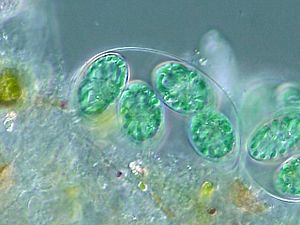Glaucophyte facts for kids
Quick facts for kids Glaucophyta |
|
|---|---|
 |
|
| Glaucocystis sp. | |
| Scientific classification |
|
| (unranked): | Archaeplastida |
| Division: | Glaucophyta Skuja 1948 |
| Class | |
|
|
| Synonyms | |
|
|
The glaucophytes are a small group of freshwater microscopic algae. Together with the red algae (Rhodophyta) and green algae plus land plants (Viridiplantae or Chloroplastida), they form the Archaeplastida.
The glaucophytes are of interest because they may be similar to the original algal type that led to green plants and red algae. The relationships between these groups are not yet clear, and the glaucophytes in particular need more study.
Characteristics
The chloroplasts of glaucophytes are known as 'cyanelles'. Unlike the chloroplasts in other organisms, they have a peptidoglycan layer, like bacterial cell walls. This is thought to be a relic of the endosymbiotic origin of plastids from cyanobacteria.
Glaucophytes have the photosynthetic pigment chlorophyll a. They harvest light with the same type of pigment molecules as do cyanobacteria and red algae. Green algae and land plants have lost that pigment, which is known as phycobiliprotein.
Glaucophyte mitochondria and flagella (if present) are similar to forms found in some green algae.
Classification
Only 13 species of glaucophytes are known, none of which is particularly common in nature. There are three genera.
The glaucophytes were previously placed in the order Chlorococcales.
See also
 In Spanish: Glaucofitas para niños
In Spanish: Glaucofitas para niños

